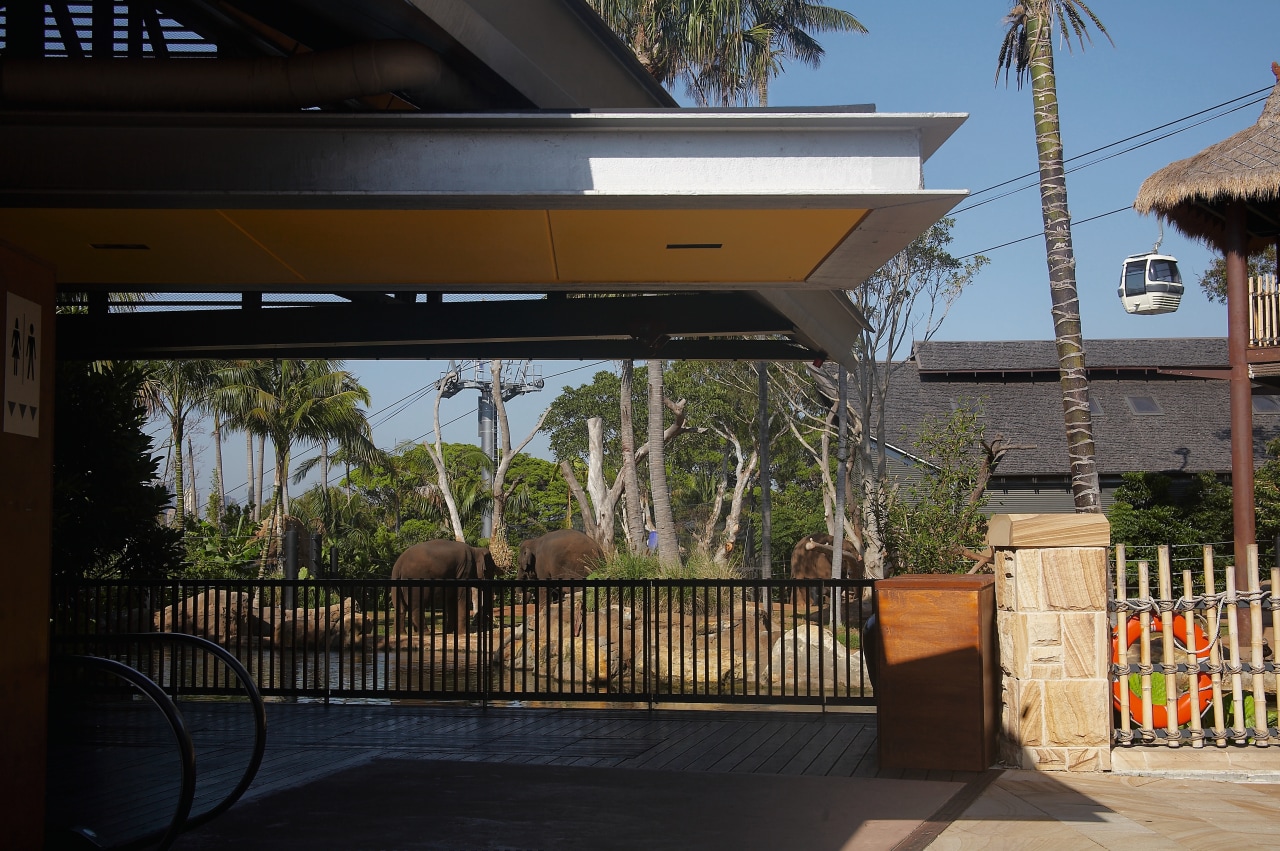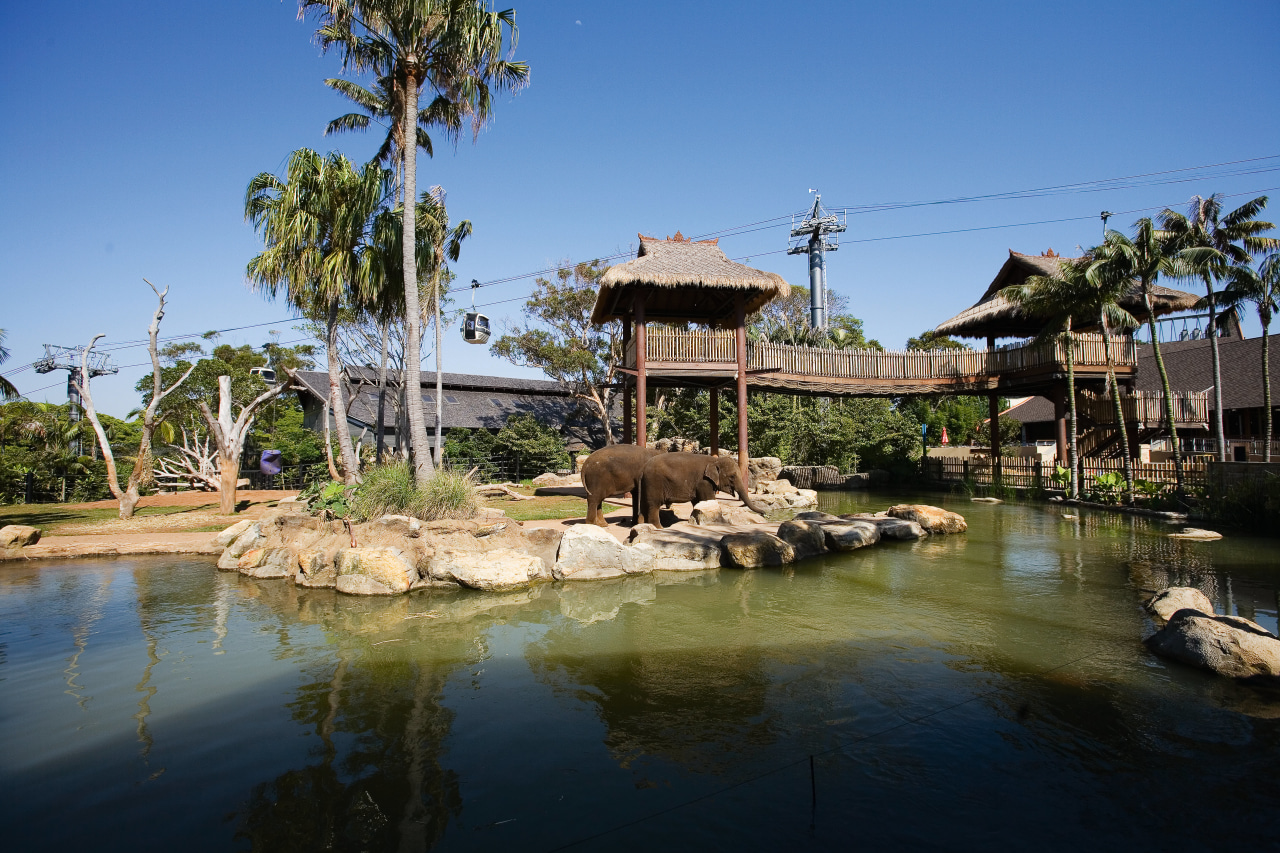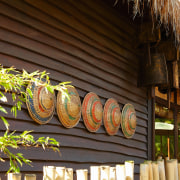It's Like A Jungle Sometimes
The ground-breaking Wild Asia precinct at Taronga Zoo creates an open environment where elephants, their natural jungle companions, and visitors all appear to share the same space

THE VERY FIRST attempts to bring the mysteries of the jungle elephant up close to curious humans involved a beleaguered beast tethered to the back of a circus caravan. Then came travelling cages, and, by the turn of the last century, zoological exhibits that created a more expansive, humane living environment.
As knowledge of animals' natural habitats has grown, so too have living conditions continued to improve. Contemporary exhibits seek to create a likeness of their natural habitat for jungle animals. Far from the concept of wild beasts being dragged to the city, today's intrepid zoo visitors could be forgiven for thinking they were trespassing on the animals' own domain.
Taronga Zoo attracts over 1.29 million visitors annually and prides itself on its progressive outlook. In 2000, a draft master plan proposed a 12-year staged development for the zoo with the intention of giving visitors an experiential, up-close-and-personal tour of themed exhibits within logical, naturalistic biographic zones.
The zoo's Wild Asia precinct, stage one of the substantial upgrade, was recently completed. This themed combination of visitor amenities and animal exhibits has been designed to replicate a typical Asian setting a slow-flowing river with a village at its banks.
Architectural firm Jackson Teece specialises in zoological design. Project architect Trevor Williams was involved in Wild Asia from initial design stages through to its completion.
"Wild Asia represents a coming together of a number of forward-looking concepts and technical and material advancements which collectively create an immersion-like experience for zoo visitors," says the architect. "The overview was to create an environment where animals from the same geographic regions and biographic environments could be grouped together with the appearance of inhabiting the same space."
To achieve this impression, Williams designed a meandering trail for visitors where one minute they would see elephants backdropped by birds of the forest and the next witness gibbering monkeys with the silhouette of a raised trunk glimpsed behind them. While contained in their own manageable habitat they would appear, at a glance, to interact in one greater enclosure.
Set in a limited area, on a sloping hillside, space allocation was a pre-eminent consideration for the precinct.
"An immersion exhibit of this scale takes plenty of space and the new Wild Asia precinct is three times larger than the original elephant enclosure in this sector of the zoo," says the architect. "A children's zoo was moved away from the area and, with this added space, a series of complex bubble diagrams was created piecing together the layout of individual animal enclosures to best overall effect."
This was a logistical challenge involving five adolescent Asian elephants a male and four females silvery gibbons, Malayan tapirs, binturongs, langur monkeys, small-clawed otters and a plethora of rainforest birds not to mention the evocatively named web-pawed fishing cats.
Threaded through these exhibits there needed to be sleeping quarters for the animals, a massive new elephant barn, food amenities for visitors and a student learning centre.
The finalised design was a distillation of earlier drawings, with previous architectural input from Sydney architects Hassell. On completion, Wild Asia achieves the sense of a naturalistic Asian riverside village by addressing several distinct elements.
Upon arrival at the precinct, visitors see the elephants at play in the river-like flowing water area. The giant animals are close at hand and seem only a disturbingly short clamber from the onlookers. However, the river on the visitors' side of the water is actually a wet moat, a deeper area that elephants can enter from the distant shallower side but not exit from the steeper side here. In the past, visible dry moats had separated elephants from observers, but these had not been designed to be entered.
"Disguise is the name of the game," says Williams. "Rock formations and trees shield fences in other areas and, importantly, the visitor is never allowed to see the enclosure in its entirety. Leaving the extent of their domain, and even the number of elephants, up to the imagination adds to the immersion experience."
With buildings an easy giveaway as to the mechanics of the zoo, they are treated in three distinct ways.
Firstly, many are themed, such as the food court near the entrance to the precinct, which has the appearance of a shingled village building. Likewise the elephant barn becomes an upscale Asian structure and an adjacent learning centre resembles an Asian-style village classroom.
The benefit of theming is that the buildings contribute to their setting while hiding their function. Materials, though Asian in appearance, are sourced locally. The cost of repairing the natural materials is built into the precinct's running costs a necessary price of authenticity. Throughout the exhibit, shingled roofs, bamboo panels and Asian artefacts greet the eye.
Advances in materials such as mock rock allow other buildings to be de-emphasised. Building concrete cliffs and paths and hillocks that have twigs, riverside rocks or other natural elements embedded into them provide ways to disguise the sides of buildings. Many of the animals' sleeping quarters are disguised in this way. Contemporary zoological design advances have seen mock rock developed to an art form, with the versatile material even designed to age naturally over time.

A third way the buildings are addressed is by simply going underground. The Hillside Link Building is an intermediary building, also completed by Jackson Teece, that leads to the next step of the zoo upgrade already under way Great Southern Ocean. The Hillside Link has the profile of a village roof on the Wild Asia side and the look of a seaside home on the ocean exhibit side. However, the huge amounts of machinery necessary for Wild Asia's river filtering plant and the adjacent Great Southern Oceans' waterways plant are tucked away out of sight and earshot in this building's cavernous basements.
No matter how astute the aesthetics of the zoo become, the welfare of the animals stands at the heart of the design. The elephants' barn, for example, is constructed with massive steel pillars that allow keepers to walk in and out between them but with the elephants safely contained. Turn-of-the-century zoos simply had niches in the concrete walls to provide safety for keepers. Automated gates, optimum heating and a soaring roof beyond the reach of even the most inquisitive trunk make the entire housing and cleaning of the elephants a safe, comfortable experience for human and beast.
The design allows visitors to see into the barn, which is in itself an expression of the elephants' natural strength. Some areas of steel enclosure fencing are also left exposed, again to imply the might of the animals.
Besides following a leaf-strewn jungle trail through the precinct, visitors can also take an overview of the Wild Asia precinct literally. The zoo's cable car takes visitors from the ferry up to the entrance of the zoo, directly over the top of the elephants. The large, grey pachyderms make a surreal sight backdropped by Sydney's urban jungle. However, the architects also had to look at the precinct's design from the other point of view as seen from the city and harbour.
"The zoo is prominent when viewed from the water and we had to liaise with the Custodians of the Harbour and their parent body, the NSW Department of Planning, regarding our design's greater aesthetic impact," says Williams. "A good example is provided by three protected mature Port Jackson fig trees near the bottom of the precinct. We took care which animal to locate in their vicinity to protect their roots and foliage, and also strategically placed the upscale elephant barn so these trees would screen the building from the harbour."
The open, geographically aligned experience presented by the Wild Asia precinct is likely to show the way forward for zoological exhibits, says the architect.
"It enables the zoo to capture the essence of life in the wild from treetop to jungle floor and with the knowledge of these delicate ecosystems, the attendant, ever-more-important message of conservation," Williams explains.
However, from a child's-eye perspective, entertainment will always be a central part of a trip to the zoo.
"Our ultimate success would be if a visitor feels slightly lost as he or she wanders a jungle trail, with leaves underfoot, the flapping of birds overhead and an elephant's trumpet sounding unnervingly close."
Credit list
Architects and exhibit design
Interpretation and theming
Structural and civic consultant
Mechanical consultant
Hydraulic consultant
Heritage consultant
Interpretive installation
Landscape consultant
Builder
Electrical consultant
Life support systems hydraulic consultant
Quantity consultant
BCA Advisor
Story by: Trendsideas
Home kitchen bathroom commercial design
Personality plus
Diving into nature
Classic looks, contemporary efficiency














